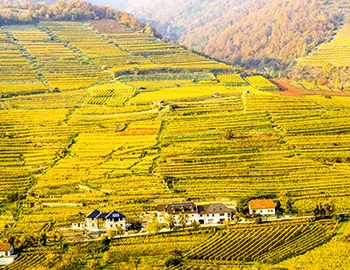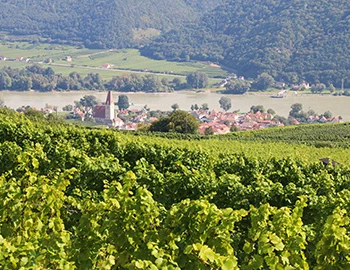Urgestein Riesling 2023
DAC Kamptal, Schlosskellerei Gobelsburg, 750 ml

| Grape variety: | Riesling |
| Producer: | Weingut Schloss Gobelsburg |
| Origin: | Austria / Niederösterreich / Kamptal |
| Other vintages: |
Description
The vines for the Urgestein Riesling feel right at ease on the distinctive sites of the Gaisberg and Heiligenstein. With a crisp minerality and a lively attack, this wine is an immediate delight. Its bouquet seduces with ripe apricot, yellow apple and a pinch of almond. The palate is full of flavour: an intense, herbal and spicy taste meets juicy peach. The perfect partner for light dishes.
Attributes
| Origin: | Austria / Niederösterreich / Kamptal |
| Grape variety: | Riesling |
| Label: | Vegan |
| Ripening potential: | 1 to 3 years |
| Drinking temperature: | 10 to 12 °C |
| Food Pairing: | Italian antipasti, Fish terrine, Goat's cheese, Vegetable flan, quiche, Salad with vegetables, pulses, pasta |
| Vinification: | pressed carefully and immediately, fermentation at low temperatures |
| Harvest: | hand-picking, strict selection, in small boxes |
| Maturation: | in steel tank |
| Bottling: | filtration |
| Volume: | 12.0 % |
| Note: | Contains sulphites |
Riesling
The cold-weather king
The Riesling is the flagship of the German wine industry. It grows from north to south in all growing areas. It is also comfortable in the neighbouring Alsace region and in Austria. Its specialty is being vinified to a variety of degrees of sweetness, from bone-dry wines to ice wine. Moreover, thanks to its spirited acidity, it ages better than many reds. The typical Riesling smells of citrus, peach and apricot, shows hints of flint, and with maturity develops an idiosyncratic petrol note. It reflects its terroir like hardly any other white variety. Thus, it often gets fuller and more aromatic in Austria than in Germany. In Alsace, in turn, it has a particular mineral taste. Riesling is a wonderful culinary companion. It fits well not only with fish and shellfish, but also takes the heaviness from hearty meals. And with a fine sweetness and acidity balance, it works wonders for Asian cuisine.

Kamptal
Kamptal: a dynamic atmosphere north of the Danube
With an ever-growing number of leading vintners, Kamptal has increasingly stood out in recent years from the shadow of the legendary Wachau region. The basis for this are the various terroirs in this broad-ranging valley. At Loisium, the region is also host to a spectacular, futuristic visitor center.

Niederösterreich
Lower Austria: crus near and far from the Danube
Austria's largest state is also its largest wine region. 46,000 hectares are planted with vines in Lower Austria. It is a heterogenic wine region, consisting of eight wine growing areas. While white varieties like Grüner Veltliner and Riesling dominate in the areas north and west of Vienna, red varieties set the tone in the south and in the southeast (Thermenregion and Carnuntum). The internationally famous white crus from Grüner Veltliner and Riesling develop in the picturesque Wachau and Kamptal.

Austria
Austria – Sumptuous culture, accessible to all
Austria is characterized by unbelievable topographical diversity. A flat steppe in the east, forests and hills in the Alpine regions, wetlands and Mediterranean landscapes in the south. This in addition to a rich tradition and even greater love. It’s no surprise that the Romans found joy on this patch of Earth and cultivated wine growing. Austrian wine is not abundant, but it is high quality.



